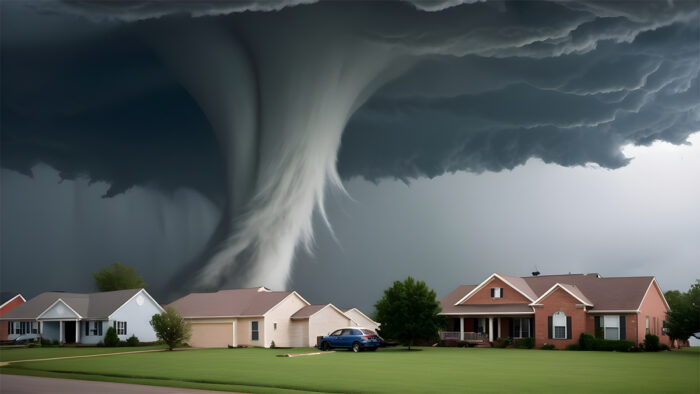Yes, most standard home insurance policies cover tornado damage. This is because tornado damage is usually covered under the windstorm section of a standard home insurance policy, and hail, wind, and tornadoes are included. Your personal property is also covered after tornado damage with homeowners insurance. However, if there is a flood, you will need to get a flood insurance policy.

When Does Home Insurance Cover Tornado Damage?
As mentioned earlier, home insurance covers tornado damage in different events. It also makes sure that your personal belongings and home are protected and safe. For a better understanding, here are scenarios where your homeowners’ insurance policy will offer coverage for tornado damage:
• Personal Property Coverage
With a home insurance policy, you get personal property coverage, which is responsible for repairing and replacing your belongings if they ever get damaged by a covered peril. Items like kitchen appliances, furniture, artwork, electronics, rugs, toys, jewelry, and clothes are covered.
Meanwhile, a home insurance policy’s property coverage is usually at a fixed percentage of the dwelling coverage, like 50% to 70%. You can create a home inventory to find out how much personal property coverage you need.
• Dwelling Coverage
Dwelling coverage in a home insurance policy is responsible for covering the physical structure of the home. Thus, if it needs to be rebuilt, the dwelling coverage will take care of it. What’s more, this coverage includes other structures in your home, like the deck and garage.
As for the fence and shed, those are covered under the other structure coverage in the quote. Nonetheless, your home insurance provider will adjust your dwelling coverage per year to determine the changes in the cost of labor and local materials.
• Additional Living Expenses Coverage
If you are unable to reside in or inhabit your house because of damage or destruction caused by a tornado, the additional living expenses coverage of your policy will cover the expenses associated with living outside. For instance, meals, hotel bills, laundry services, and other costs. This type of coverage is sometimes known as loss of use.
When Does It Not Offer Coverage?
Here are scenarios where your home insurance policy will not cover damage from a tornado:
- Vehicle Damage: Comprehensive coverage in car insurance can be used for this issue.
- Maintenance Issues: Damages caused by pre-existing deterioration and poor maintenance of the property are not covered.
- Certain Exclusions: Any perils that are not mentioned or part of your quote will not be covered.
Additional Home Insurance Coverage for Tornado Damage
Here are some extra home insurance coverages that you can get if you are in a tornado-prone area and do not have sufficient coverage for other issues:
Extended Replacement Cost Coverage: This coverage includes extra protection and offers more funds than your policy’s limit to rebuild your home. This is quite beneficial for those in areas prone to tornadoes.
Guaranteed Replacement Cost Coverage: With this type of coverage, you will receive reimbursement for the repairs to your home without fixed coverage limits. Therefore, if your home is destroyed by a tornado, as well as other neighbors, the rebuilding costs will be covered.
How Much Does Tornado Insurance Cost?
The cost of tornado insurance varies depending on the value of your home, its location, your policy’s deductibles, and your coverage limits. However, people living in tornado-prone areas may get higher premiums, but it is part of the standard insurance cost instead of being a separate fee.
How to Prepare for Tornado Damage
Here is how you can prepare for tornado damage:
- Confirm the tornado strength.
- Strengthen and support your doors and windows.
- Make a list of your personal possessions or belongings.
- Brace your roof.
- Map out an emergency plan.
- Prepare an emergency kit.
How to File a Claim Against Tornado Damage
Here are the steps you need to follow if you would like to file a claim against tornado damage:
- Safety First: Make sure it is safe to go back to your property.
- Document damage: Take videos or photos of the damage as evidence.
- Review your policy: Understand your coverage, deductible, and limits.
- Contact your insurer: Next, file a claim with your insurance provider as soon as possible and provide the necessary documentation and information.
- Keep Records: Document all communication and discussions with your insurance provider and keep receipts for any expenses you make regarding temporary living expenses or repairs.
Managing tornado damage carefully involves understanding your coverage, making preparations in advance, and being aware of the necessary procedures required for filing a claim effectively and swiftly.



